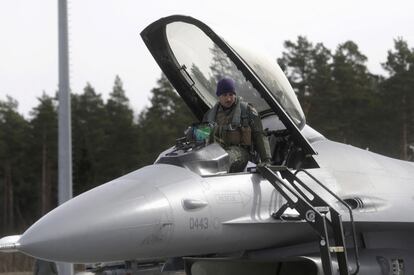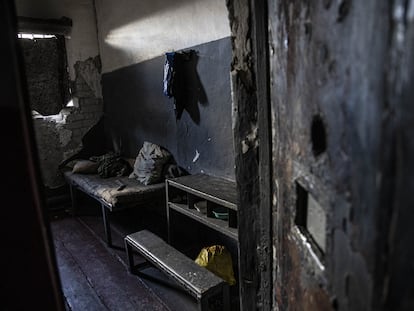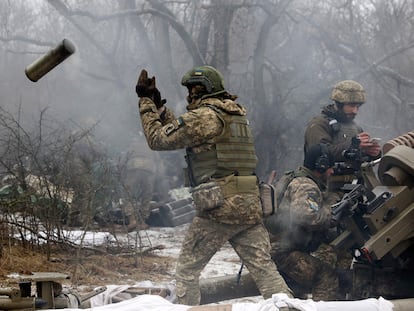Ukraine redoubles pressure on NATO allies to provide F-16 fighters
Having convinced Germany and the US to transfer Leopard and Abrams tanks, Kyiv has now turned attention to its depleted and outgunned Air Force


Kyiv’s request for NATO tanks ahead of a spring counter-offensive against heavily defended Russian positions on the eastern front has finally borne fruit, with the USA and the EU pledging to provide Abrams and Leopard 2 heavy armor to the Armed Forces of Ukraine. Now, the government of Volodymyr Zelenskiy is planning to ask for another huge leap in Western military aid, one that many in Washington view as dangerous and technically too complicated to fulfil: supplying fighters to the Ukrainian Air Force.
Oleksiy Melnik, co-director of the Razumkov Centre security and defense this tank in Kyiv, told EL PAÍS on Thursday that practically every type of armament Kyiv has requested since the Russian invasion began almost a year ago has involved lengthy negotiations and intense public debate before being agreed to. The case of the Leopard tanks is paradigmatic, as was the repeated US refusal to deliver Patriot anti-aircraft batteries. Both are now being prepared for use by the Ukrainian military. Even before the full-scale war launched by the Kremlin last February, there was heated debate in 2018 about the advisability of providing Javelin anti-tank missiles to Kyiv’s forces fighting in the Donbas conflict. The same underlying concern has been at the root of all Western hesitancy: that providing certain weapons to Moscow’s enemies will lead to an escalation of the war.
Last week, at a meeting of Ukraine’s allies in Ramstein, Germany, Zelenskiy put a name to the next request his government will make of Washington: the supply of F-16 fighter jets to the Ukrainian Air Force. “We have to unlock the supply of long-range missiles to Ukraine, it is important for us to expand our cooperation in artillery, we have to achieve the supply of aircraft to Ukraine,” Zelenskiy said during his nightly address on Wednesday, adding that such materiel was a “dream, and an important task for all of us.”

F-16 the world’s most-used fighter aircraft
The F-16 was first produced during the 1970s by US company Lockheed Martin. Since the first aircraft went into service with the United States Air Force (USAF) in 1978 there have been several upgraded variants and it is the most-used fighter aircraft in the world with 25 national air forces flying them. Like the Germany-produced Leopard tank, the F-16 is a proven successful weapon of war and like the Leopard, the country that produces it has the right to veto its export. As such, the White House has the final say on whether Kyiv will be supplied with F-16s.
Slovakia and the Netherlands have offered to send their oldest F-16s to Ukraine, which are due to be replaced by more modern versions. Slovakia’s Defense Minister Jaroslav Nad has also said his government is willing to provide training. Last summer the US Congress approved $100 million earmarked to train Ukrainian pilots to operate F-16s and F-15s. The Ukrainian Air Force confirmed last November that it was selecting the personnel to be put forward for training on the new aircraft.
However, US President Joe Biden said last December that Washington was reluctant to provide weaponry to Ukraine that could be used to hit targets on Russian soil, for fear of sparking a new World War. Kyiv’s attempts to secure US long-range missile systems, primarily the ATACMS, which has a range of up to 185 miles, and the less powerful but extremely precise GLSDB. Due their range and armament, fighters have also fallen under the White House veto to date.
“Mutual air denial”
There is another reason Ukraine’s NATO allies have proven reluctant to provide aircraft to Kyiv: the effectiveness of anti-aircraft batteries in both the Russian and Ukrainian military. Few aircraft of the Russian and Ukrainian air forces are ever seen flying over the invaded country, except on the front lines, where they limit their combat operations to swift sorties close to their bases.
At a seminar sponsored by the Atlantic Council last September, retired USAF General Philip Breedlove described the situation in the skies over Ukraine as “mutual air denial.” Air power has ceased to play a meaningful role in the war because the mobile air defense batteries of both sides have negated the aerial threat.
This mutual air denial benefits Kyiv because its fleet of aircraft and helicopters is vastly inferior to Moscow’s. According to a 2023 analysis carried out by leading aeronautical industry publication Flight Global, the Russian Air force has 4,182 operational machines to Ukraine’s 312. The most potent aircraft Kyiv can deploy are the MiG-29 – which was designed by the Soviet Union precisely to counter the US F-16 – the Su-27 and the Mi-8 attack helicopter. However, the numbers available are small: 43, 26 and 16, respectively. None of Kyiv’s available fighters are a match for the more modern MiG-31s, Su-27-30 variants and Su-34s operated by the Russians.
Melnik and other experts consulted believe that Western fighters will eventually be supplied to Kyiv, but none were convinced this will occur in 2023. General James B. Hecker, commander of United States Air Forces in Europe – Air Forces Africa and Allied Air Command, told Politico last September that, due to logistical and technical issues, it would be two to three years before Ukraine could deploy F-16s after any decision was reached to supply them.
Ukrainian military analysis publication Defense Express suggested last November that instead of F-16s it would be more practical to supply the Ukrainian Air Force with MiG-29s already in the possession of former Soviet bloc countries. Poland offered to provide MiG-29s in March 2022, but officially retracted at Washington’s request to avoid an escalation with Moscow. However, Polish daily Dziennik published a report on Thursday suggesting that Warsaw had sent MiGs to Kyiv secretly last spring.
Sign up for our weekly newsletter to get more English-language news coverage from EL PAÍS USA Edition
Tu suscripción se está usando en otro dispositivo
¿Quieres añadir otro usuario a tu suscripción?
Si continúas leyendo en este dispositivo, no se podrá leer en el otro.
FlechaTu suscripción se está usando en otro dispositivo y solo puedes acceder a EL PAÍS desde un dispositivo a la vez.
Si quieres compartir tu cuenta, cambia tu suscripción a la modalidad Premium, así podrás añadir otro usuario. Cada uno accederá con su propia cuenta de email, lo que os permitirá personalizar vuestra experiencia en EL PAÍS.
¿Tienes una suscripción de empresa? Accede aquí para contratar más cuentas.
En el caso de no saber quién está usando tu cuenta, te recomendamos cambiar tu contraseña aquí.
Si decides continuar compartiendo tu cuenta, este mensaje se mostrará en tu dispositivo y en el de la otra persona que está usando tu cuenta de forma indefinida, afectando a tu experiencia de lectura. Puedes consultar aquí los términos y condiciones de la suscripción digital.
More information
Archived In
Últimas noticias
Most viewed
- Oona Chaplin: ‘I told James Cameron that I was living in a treehouse and starting a permaculture project with a friend’
- Sinaloa Cartel war is taking its toll on Los Chapitos
- Reinhard Genzel, Nobel laureate in physics: ‘One-minute videos will never give you the truth’
- Why the price of coffee has skyrocketed: from Brazilian plantations to specialty coffee houses
- Silver prices are going crazy: This is what’s fueling the rally










































